Validity and Reliability of Kinect v2 for Quantifying Upper Body Kinematics during Seated Reaching
Abstract
:1. Introduction
2. Materials and Methods
2.1. Participants
2.2. Experimental Protocol
2.3. Experimental Setup
2.3.1. Vicon Sensor
2.3.2. Kinect Sensor
2.3.3. Position of Landmarks for the Vicon and for the Kinect
2.4. Data Processing
2.5. Statistical Analysis
3. Results
- Angles
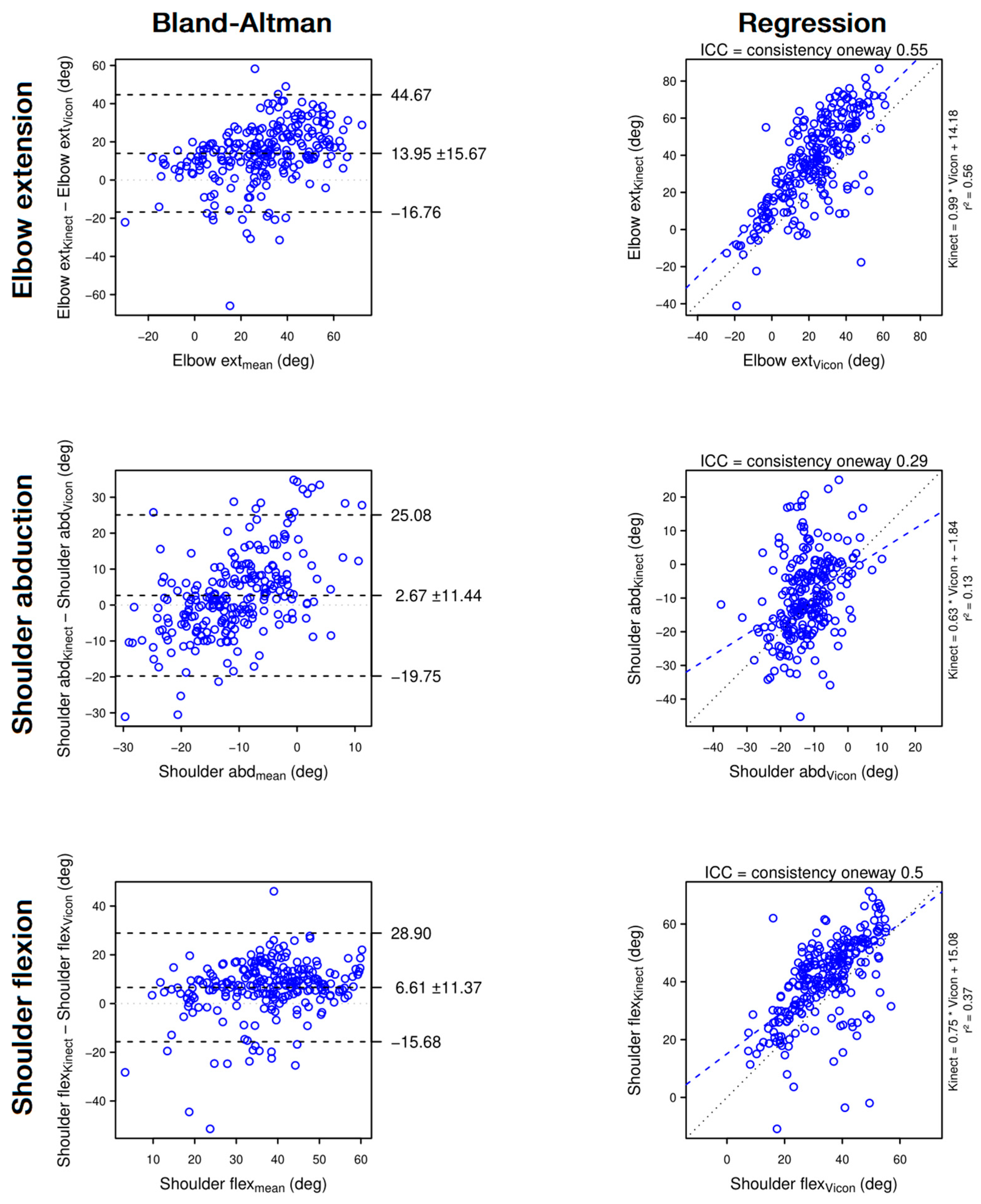

- Efficiency, Planning and Smoothness

- Speed
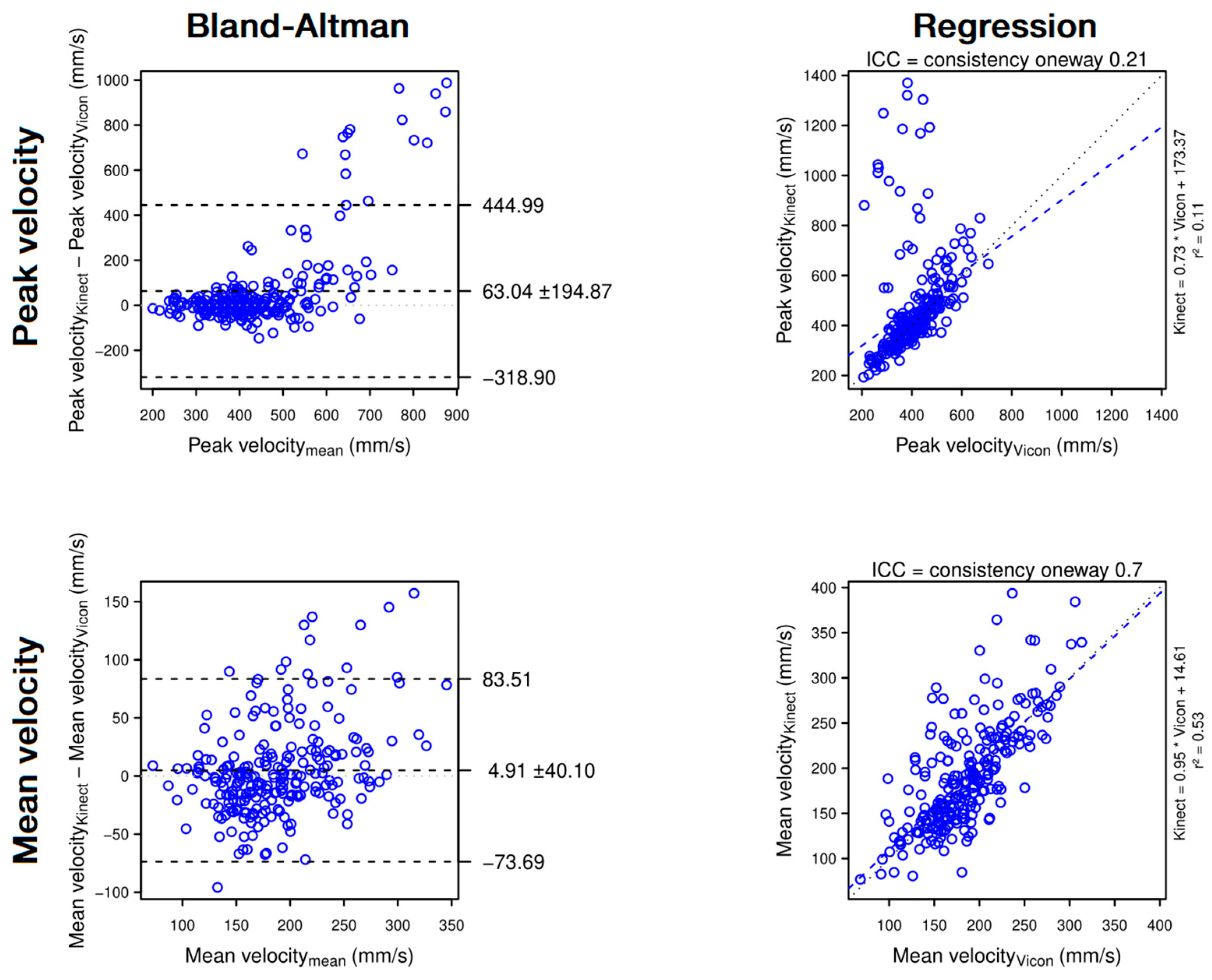
- Displacements
4. Discussion
4.1. Validation of the Kinematic Assessment Obtained by Kinect
4.1.1. Trunk Motion
4.1.2. Hand Motion
4.1.3. The Problem of Elbow in a Seated Reaching Task
4.2. Smoothing out KINECT Errors
4.3. Kinematic Assessment of the Upper Limb in Clinical Routine for Personalised Rehabilitation Post-Stroke
4.3.1. Markerless Motion Capture Advantages for Kinematic Assessment
4.3.2. Kinematic Assessment to Better Understand the Level of Motor Recovery of the Patient
4.3.3. Early and Regular Kinematic Assessment to Individualise Rehabilitation, Enhance Motivation and Improve Recovery
4.4. Limitations of the Study
4.5. Future Work
5. Conclusions
Supplementary Materials
Author Contributions
Funding
Institutional Review Board Statement
Informed Consent Statement
Data Availability Statement
Acknowledgments
Conflicts of Interest
References
- Jones, T.A. Motor compensation and its effects on neural reorganization after stroke. Nat. Rev. Neurosci. 2017, 18, 267–280. Available online: https://www.researchgate.net/publication/315526603_Motor_compensation_and_its_effects_on_neural_reorganization_after_stroke (accessed on 30 October 2018). [CrossRef] [PubMed]
- Collins, K.C.; Kennedy, N.C.; Clark, A.; Pomeroy, V.M. Kinematic components of the reach-to-target movement after stroke for focused rehabilitation interventions: Systematic Review and meta-analysis. Front. Neurol. 2018, 9, 472. [Google Scholar] [CrossRef] [PubMed]
- Patterson, T.S.; Bishop, M.D.; McGuirk, T.E.; Sethi, A.; Richards, L.G. Reliability of Upper extremity kinematics while performing different tasks in individuals with stroke. J. Mot. Behav. 2011, 43, 121–130. [Google Scholar] [CrossRef]
- Alt Murphy, M.; Resteghini, C.; Feys, P.; Lamers, I. An overview of systematic reviews on upper extremity outcome measures after stroke. BMC Neurol. 2015, 15, 29. [Google Scholar] [CrossRef] [PubMed] [Green Version]
- Bakhti, K.K.A.; Mottet, D.; Schweighofer, N.; Froger, J.; Laffont, I. Proximal arm non-use when reaching after a stroke. Neurosci. Lett. 2017, 657, 91–96. [Google Scholar] [CrossRef]
- Roby-Brami, A.; Feydy, A.; Combeaud, M.; Biryukova, E.V.; Bussel, B.; Levin, M.F. Motor compensation and recovery for reaching in stroke patients. Acta Neurol. Scand. 2003, 107, 369–381. [Google Scholar] [CrossRef]
- Levin, M.F.; Kleim, J.A.; Wolf, S.L. What Do motor “recovery” and “compensation” mean in patients following stroke? Neurorehabil. Neural Repair 2009, 23, 313–319. [Google Scholar] [CrossRef]
- Subramanian, S.K.; Yamanaka, J.; Chilingaryan, G.; Levin, M.F. Validity of movement pattern kinematics as measures of arm motor impairment poststroke. Stroke 2010, 41, 2303–2308. [Google Scholar] [CrossRef] [Green Version]
- van Dokkum, L.; Hauret, I.; Mottet, D.; Froger, J.; Métrot, J.; Laffont, I. The Contribution of kinematics in the assessment of upper limb motor recovery early after stroke. Neurorehabil. Neural Repair 2014, 28, 4–12. [Google Scholar] [CrossRef]
- Beebe, J.A.; Lang, C.E. Active range of motion predicts upper extremity function 3 months after stroke. Stroke 2009, 40, 1772–1779. [Google Scholar] [CrossRef] [PubMed]
- Chen, H.; Lin, K.; Liing, R.; Wu, C.; Chen, C. Kinematic measures of Arm-trunk movements during unilateral and bilateral reaching predict clinically important change in perceived arm use in daily activities after intensive stroke rehabilitation. J. NeuroEng. Rehabil. 2015, 12, 84. [Google Scholar] [CrossRef] [Green Version]
- Cirstea, M.C.; Levin, M.F. Compensatory strategies for reaching in stroke. Brain 2000, 123, 940–953. [Google Scholar] [CrossRef]
- Levin, M.F.; Liebermann, D.G.; Parmet, Y.; Berman, S. Compensatory versus noncompensatory shoulder movements used for reaching in stroke. Neurorehabil. Neural Repair 2016, 30, 635–646. [Google Scholar] [CrossRef] [Green Version]
- Laffont, I.; Froger, J.; Jourdan, C.; Bakhti, K.; van Dokkum, L.E.H.; Gouaich, A.; Bonnin, H.Y.; Armingaud, P.; Jaussent, A.; Picot, M.C.; et al. Rehabilitation of the upper arm early after stroke: Video games versus conventional rehabilitation. A randomized controlled trial. Ann. Phys. Rehabil. Med. 2020, 63, 173–180. [Google Scholar] [CrossRef]
- Laver, K.E.; Lange, B.; George, S.; Deutsch, J.E.; Saposnik, G.; Crotty, M. Virtual reality for stroke rehabilitation. Cochrane Database Syst. Rev. 2017, 11, CD008349. [Google Scholar] [CrossRef] [Green Version]
- Springer, S.; Seligmann, G.Y. Validity of the kinect for gait assessment: A focused review. Sensors 2016, 16, 194. [Google Scholar] [CrossRef]
- Corti, A.; Giancola, S.; Mainetti, G.; Sala, R. A metrological characterization of the Kinect V2 time-of-flight camera. Robot. Auton. Syst. 2016, 75, 584–594. [Google Scholar] [CrossRef]
- Mortazavi, F.; Nadian-Ghomsheh, A. Stability of kinect for range of motion analysis in static stretching exercises. PLoS ONE 2018, 13, e0200992. [Google Scholar] [CrossRef]
- Çubukçu, B.; Yüzgeç, U.; Zileli, R.; Zileli, A. Reliability and validity analyzes of Kinect V2 based measurement system for shoulder motions. Med. Eng. Phys. 2020, 76, 20–31. [Google Scholar] [CrossRef]
- Kuster, R.P.; Heinlein, B.; Bauer, C.M.; Graf, E.S. Accuracy of KinectOne to quantify kinematics of the upper body. Gait Posture 2016, 47, 80–85. [Google Scholar] [CrossRef]
- Scano, A.; Mira, R.M.; Cerveri, P.; Molinari Tosatti, L.; Sacco, M. Analysis of upper-limb and trunk kinematic variability: Accuracy and reliability of an RGB-D sensor. Multimodal Technol. Interact. 2020, 4, 14. [Google Scholar] [CrossRef]
- Zulkarnain, R.F.; Kim, G.-Y.; Adikrishna, A.; Hong, H.P.; Kim, Y.J.; Jeon, I.-H. Digital data acquisition of shoulder range of motion and arm motion smoothness using Kinect V2. J. Shoulder Elbow Surg. 2017, 26, 895–901. [Google Scholar] [CrossRef] [PubMed]
- Cai, L.; Ma, Y.; Xiong, S.; Zhang, Y. Validity and reliability of upper limb functional assessment using the microsoft kinect V2 sensor. Appl. Bionics Biomech. 2019, 2019, e7175240. [Google Scholar] [CrossRef] [Green Version]
- Mentiplay, B.F.; Perraton, L.G.; Bower, K.J.; Pua, Y.-H.; McGaw, R.; Heywood, S.; Clark, R.A. Gait assessment using the Microsoft Xbox One Kinect: Concurrent validity and inter-day reliability of spatiotemporal and kinematic variables. J. Biomech. 2015, 48, 2166–2170. [Google Scholar] [CrossRef] [PubMed]
- Humadi, A.; Nazarahari, M.; Ahmad, R.; Rouhani, H. In-field instrumented ergonomic risk assessment: Inertial measurement units versus Kinect V2. Int. J. Ind. Ergon. 2021, 84, 103147. [Google Scholar] [CrossRef]
- Bakhti, K.K.A.; Laffont, I.; Muthalib, M.; Froger, J.; Mottet, D. Kinect-based assessment of proximal arm non-use after a stroke. J. NeuroEng. Rehabil. 2018, 15, 104. [Google Scholar] [CrossRef]
- Scano, A.; Molteni, F.; Molinari Tosatti, L. Low-cost tracking systems allow fine biomechanical evaluation of upper-limb daily-life gestures in healthy people and post-stroke patients. Sensors 2019, 19, 1224. [Google Scholar] [CrossRef] [PubMed] [Green Version]
- Sheng, B.; Wang, X.; Hou, M.; Huang, J.; Xiong, S.; Zhang, Y. An automated system for motor function assessment in stroke patients using motion sensing technology: A pilot study. Measurement 2020, 161, 107896. [Google Scholar] [CrossRef]
- Sheng, B.; Wang, X.; Xiong, S.; Hou, M.; Zhang, Y. Kinematic Metrics for upper-limb functional assessment of stroke patients. In Proceedings of the 2019 International Conference on Intelligent Informatics and Biomedical Sciences (ICIIBMS), Shanghai, China, 21–24 November 2019; pp. 45–51. [Google Scholar]
- Ayed, I. Vision-based serious games and virtual reality systems for motor rehabilitation: A review geared toward a research methodology. Int. J. Med. Inform. 2019, 131, 103909. [Google Scholar] [CrossRef]
- Faity, G.; Mottet, D.; Pla, S.; Froger, J. The reserve of joint torque determines movement coordination. Sci. Rep. 2021, 11, 23008. [Google Scholar] [CrossRef] [PubMed]
- Nichols, J.K.; Sena, M.P.; Hu, J.L.; O’Reilly, O.M.; Feeley, B.T.; Lotz, J.C. A Kinect-based movement assessment system: Marker position comparison to Vicon. Comput. Methods Biomech. Biomed. Eng. 2017, 20, 1289–1298. [Google Scholar] [CrossRef]
- Merriaux, P.; Dupuis, Y.; Boutteau, R.; Vasseur, P.; Savatier, X. A study of vicon system positioning performance. Sensors 2017, 17, 1591. [Google Scholar] [CrossRef] [PubMed]
- Da Gama, A.; Fallavollita, P.; Teichrieb, V.; Navab, N. Motor rehabilitation using kinect: A systematic review. Games Health J. 2015, 4, 123–135. [Google Scholar] [CrossRef]
- Lupinacci, G.; Gatti, G.; Angilica, A.; Muzzupappa, M. Kinect V2 for Upper Limb Rehabilitation Applications—A Preliminary Analysis on Performance Evaluation. In Proceedings of the 9th International Joint Conference on Biomedical Engineering Systems and Technologies, Rome, Italy, 21–23 February 2016; SCITEPRESS—Sience and and Technology Publications: Rome, Italy, 2016; pp. 131–138. [Google Scholar]
- Xu, X.; Robertson, M.; Chen, K.B.; Lin, J.; McGorry, R.W. Using the Microsoft KinectTM to assess 3-D shoulder kinematics during computer use. Appl. Ergon. 2017, 65, 418–423. [Google Scholar] [CrossRef]
- Arun, K.S.; Huang, T.S.; Blostein, S.D. Least-Squares Fitting of Two 3-D Point Sets. IEEE Trans. Pattern Anal. Mach. Intell. 1987, PAMI-9, 698–700. [Google Scholar] [CrossRef] [Green Version]
- Nghia. Nghiaho12/rigid_transform_3D. 2020. Available online: https://github.com/nghiaho12/rigid_transform_3D (accessed on 16 February 2022).
- Altman, D.G.; Bland, J.M. Measurement in medicine: The analysis of method comparison studies. J. R. Stat. Soc. Ser. D 1983, 32, 307–317. [Google Scholar] [CrossRef]
- Koo, T.K.; Li, M.Y. A Guideline of selecting and reporting intraclass correlation coefficients for reliability research. J. Chiropr. Med. 2016, 15, 155–163. [Google Scholar] [CrossRef] [PubMed] [Green Version]
- Schwarz, A.; Kanzler, C.M.; Lambercy, O.; Luft, A.R.; Veerbeek, J.M. Systematic review on kinematic assessments of upper limb movements after stroke. Stroke 2019, 50, 718–727. [Google Scholar] [CrossRef]
- Cutti, A.G.; Paolini, G.; Troncossi, M.; Cappello, A.; Davalli, A. Soft tissue artefact assessment in humeral axial rotation. Gait Posture 2005, 21, 341–349. [Google Scholar] [CrossRef] [PubMed]
- Xu, X.; McGorry, R.W. The validity of the first and second generation Microsoft KinectTM for identifying joint center locations during static postures. Appl. Ergon. 2015, 49, 47–54. [Google Scholar] [CrossRef]
- Cai, L.; Liu, D.; Ma, Y. Placement Recommendations for single kinect-based motion capture system in unilateral dynamic motion analysis. Healthcare 2021, 9, 1076. [Google Scholar] [CrossRef] [PubMed]
- Levin, M.F. Interjoint coordination during pointing movements is disrupted in spastic hemiparesis. Brain 1996, 119, 281–293. [Google Scholar] [CrossRef] [Green Version]
- Ma, Y.; Liu, D.; Cai, L. Deep learning-based upper limb functional assessment using a single kinect v2 sensor. Sensors 2020, 20, 1903. [Google Scholar] [CrossRef] [PubMed] [Green Version]
- Jun, C.; Lee, J.Y.; Kim, B.H.; Noh, S.D. Automatized modeling of a human engineering simulation using Kinect. Robot. Comput. Integr. Manuf. 2019, 55, 259–264. [Google Scholar] [CrossRef]
- Moon, S.; Park, Y.; Ko, D.W.; Suh, I.H. Multiple Kinect sensor fusion for human skeleton tracking using kalman filtering. Int. J. Adv. Robot. Syst. 2016, 13, 65. [Google Scholar] [CrossRef] [Green Version]
- Ryselis, K.; Petkus, T.; Blažauskas, T.; Maskeliūnas, R.; Damaševičius, R. Multiple Kinect based system to monitor and analyze key performance indicators of physical training. Hum. Cent. Comput. Inf. Sci. 2020, 10, 51. [Google Scholar] [CrossRef]
- Beshara, P.; Chen, J.F.; Read, A.C.; Lagadec, P.; Wang, T.; Walsh, W.R. The Reliability and validity of wearable inertial sensors coupled with the microsoft kinect to measure shoulder range-of-motion. Sensors 2020, 20, 7238. [Google Scholar] [CrossRef] [PubMed]
- Chen, P.; Du, Y.; Shih, C.; Yang, L.; Lin, H.; Fan, S. Development of an upper limb rehabilitation system using inertial movement units and kinect device. In Proceedings of the 2016 International Conference on Advanced Materials for Science and Engineering (ICAMSE), Tainan, Taiwan, 12–13 November 2016; pp. 275–278. [Google Scholar]
- Jatesiktat, P.; Anopas, D.; Ang, W.T. Personalized Markerless upper-body tracking with a depth camera and wrist-worn inertial measurement units. In Proceedings of the 2018 40th Annual International Conference of the IEEE Engineering in Medicine and Biology Society (EMBC), Honolulu, HI, USA, 17–21 July 2018; pp. 1–6. [Google Scholar]
- Li, R.; Si, W.; Weinmann, M.; Klein, R. Constraint-based optimized human skeleton extraction from single-depth camera. Sensors 2019, 19, 2604. [Google Scholar] [CrossRef] [PubMed] [Green Version]
- Mottet, D.; van Dokkum, L.E.H.; Froger, J.; Gouaich, A.; Laffont, I. Trajectory formation principles are the same after mild or moderate stroke. PLoS ONE 2017, 12, e0173674. [Google Scholar] [CrossRef] [PubMed]
- Murphy, M.A.; Willén, C.; Sunnerhagen, K.S. Kinematic variables quantifying upper-extremity performance after stroke during reaching and drinking from a glass. Neurorehabil. Neural Repair 2011, 25, 71–80. [Google Scholar] [CrossRef]
- Dombovy, M.L.; Sandok, B.A.; Basford, J.R. Rehabilitation for stroke: A review. Stroke 1986, 17, 363–369. [Google Scholar] [CrossRef] [PubMed] [Green Version]
- Coupar, F.; Pollock, A.; Rowe, P.; Weir, C.; Langhorne, P. Predictors of upper limb recovery after stroke: A systematic review and meta-analysis. Clin. Rehabil. 2012, 26, 291–313. [Google Scholar] [CrossRef] [PubMed]
- Goffredo, M.; Pournajaf, S.; Proietti, S.; Gison, A.; Posteraro, F.; Franceschini, M. Retrospective Robot-measured upper limb kinematic data from stroke patients are novel biomarkers. Front. Neurol. 2021, 12, 803901. [Google Scholar] [CrossRef] [PubMed]
- Popović, M.D.; Kostić, M.D.; Rodić, S.Z.; Konstantinović, L.M. Feedback-mediated upper extremities exercise: Increasing patient motivation in poststroke rehabilitation. BioMed Res. Int. 2014, 2014, e520374. [Google Scholar] [CrossRef] [PubMed] [Green Version]
- Cirstea, C.M.; Ptito, A.; Levin, M.F. Feedback and cognition in arm motor skill reacquisition after stroke. Stroke 2006, 37, 1237–1242. [Google Scholar] [CrossRef] [PubMed]
- Subramanian, S.K.; Massie, C.L.; Malcolm, M.P.; Levin, M.F. Does provision of extrinsic feedback result in improved motor learning in the upper limb poststroke? A systematic review of the evidence. Neurorehabil. Neural Repair 2010, 24, 113–124. [Google Scholar] [CrossRef] [PubMed]
- Rodrigues, M.R.M.; Slimovitch, M.; Chilingaryan, G.; Levin, M.F. Does the finger-to-nose test measure upper limb coordination in chronic stroke? J. NeuroEng. Rehabil. 2017, 14, 6. [Google Scholar] [CrossRef] [Green Version]
- Subramanian, S.K.; Cross, M.K.; Hirschhauser, C.S. Virtual reality interventions to enhance upper limb motor improvement after a stroke: Commonly used types of platform and outcomes. Disabil. Rehabil. Assist. Technol. 2022, 17, 107–115. [Google Scholar] [CrossRef] [PubMed]
- Desmarais, Y.; Mottet, D.; Slangen, P.; Montesinos, P. A review of 3D human pose estimation algorithms for markerless motion capture. Comput. Vis. Image Underst. 2021, 212, 103275. [Google Scholar] [CrossRef]
- Cao, Z.; Hidalgo, G.; Simon, T.; Wei, S.-E.; Sheikh, Y. OpenPose: Realtime Multi-Person 2D Pose Estimation Using Part Affinity Fields. IEEE Trans. Pattern Anal. Mach. Intell. 2021, 43, 172–186. [Google Scholar] [CrossRef] [PubMed] [Green Version]
- Pavllo, D.; Feichtenhofer, C.; Grangier, D.; Auli, M. 3D Human pose estimation in video with temporal convolutions and semi-supervised training. In Proceedings of the 2019 IEEE/CVF Conference on Computer Vision and Pattern Recognition (CVPR), Long Beach, CA, USA, 15–20 June 2019; pp. 7745–7754. [Google Scholar]
- Iskakov, K.; Burkov, E.; Lempitsky, V.; Malkov, Y. Learnable triangulation of human pose. In Proceedings of the 2019 IEEE/CVF International Conference on Computer Vision (ICCV), Seoul, Korea, 27 October–2 November 2019; pp. 7717–7726. [Google Scholar]
- Tölgyessy, M.; Dekan, M.; Chovanec, Ľ.; Hubinský, P. Evaluation of the azure kinect and its comparison to kinect V1 and kinect V2. Sensors 2021, 21, 413. [Google Scholar] [CrossRef] [PubMed]
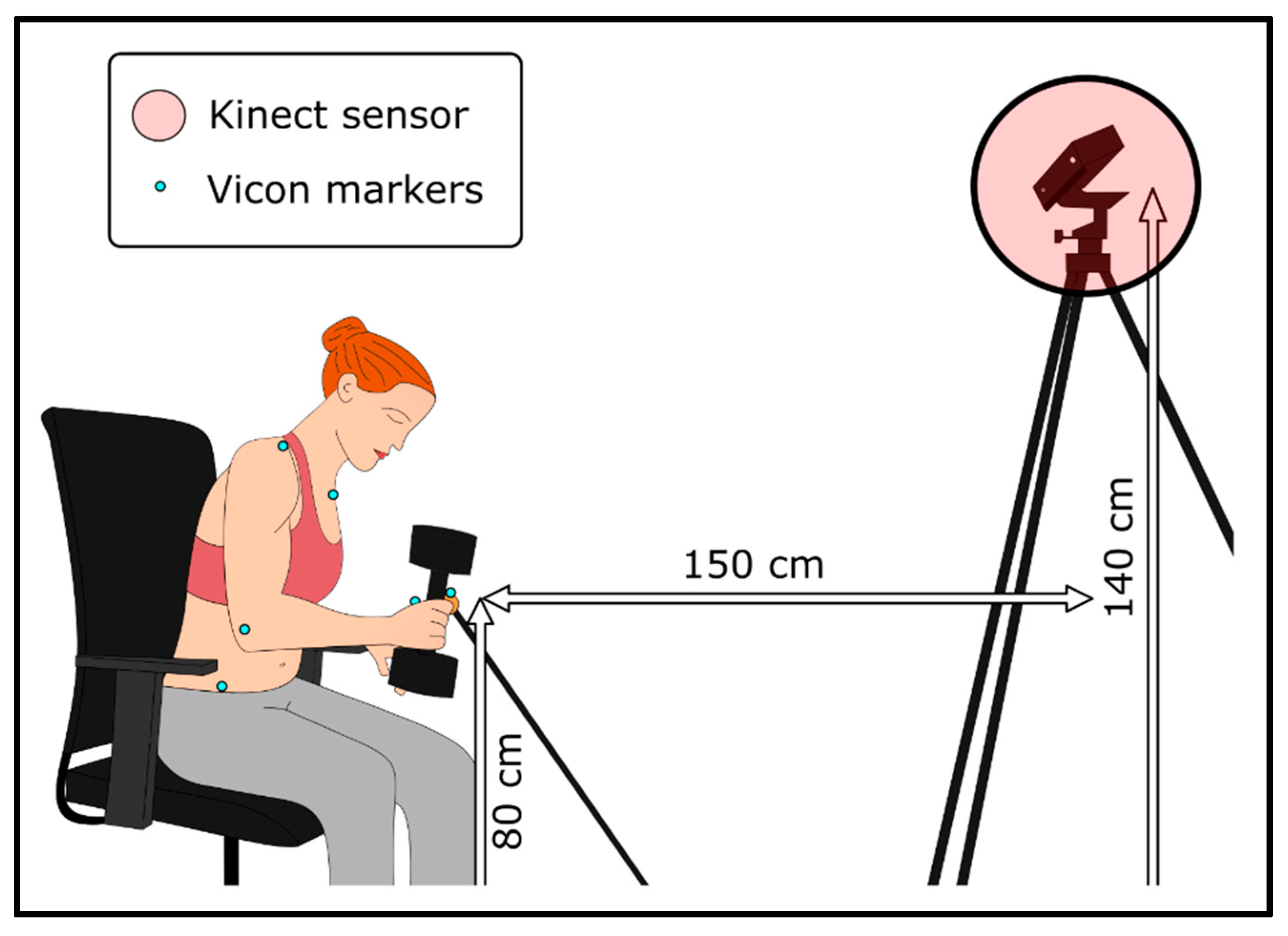
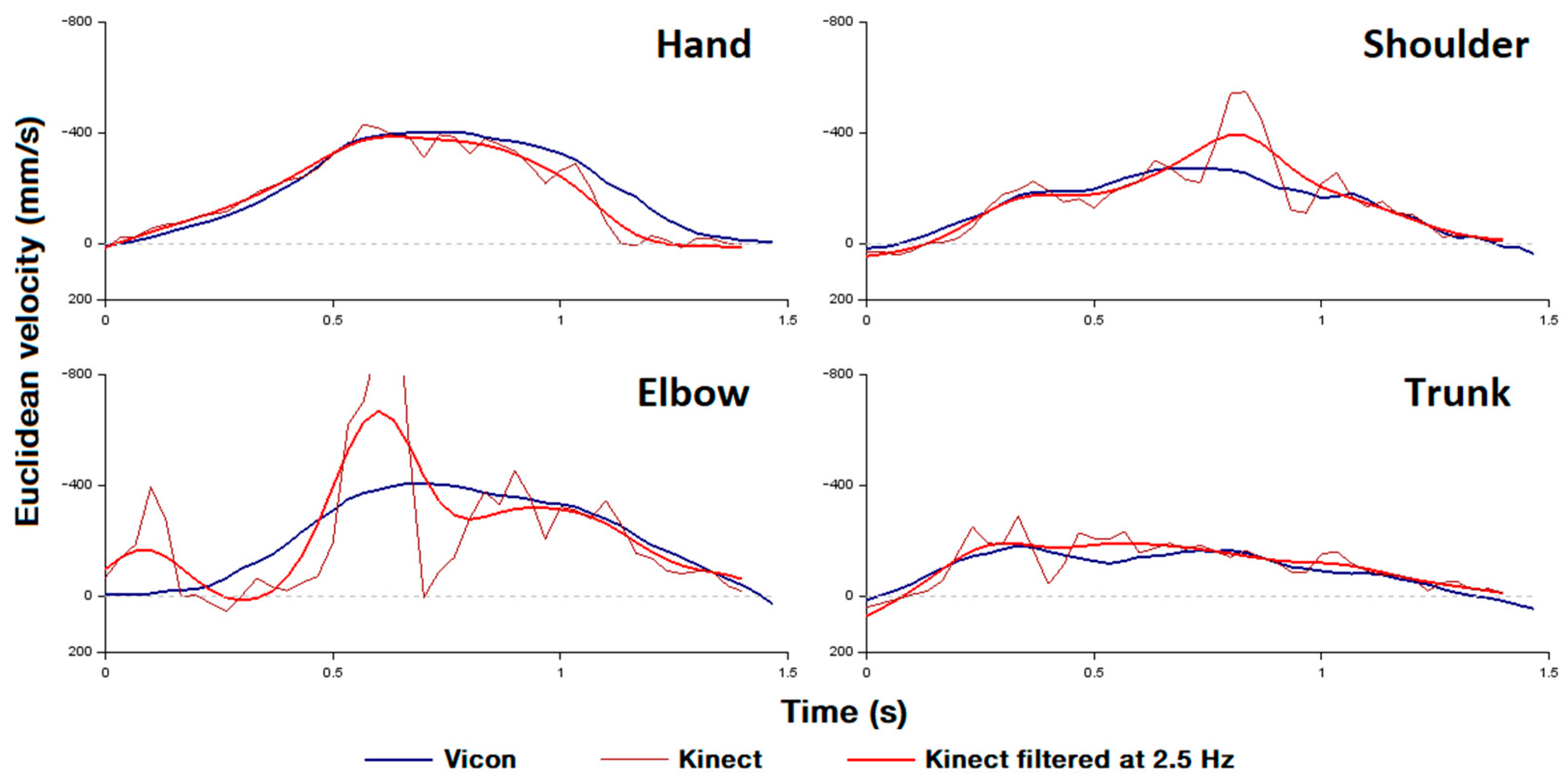
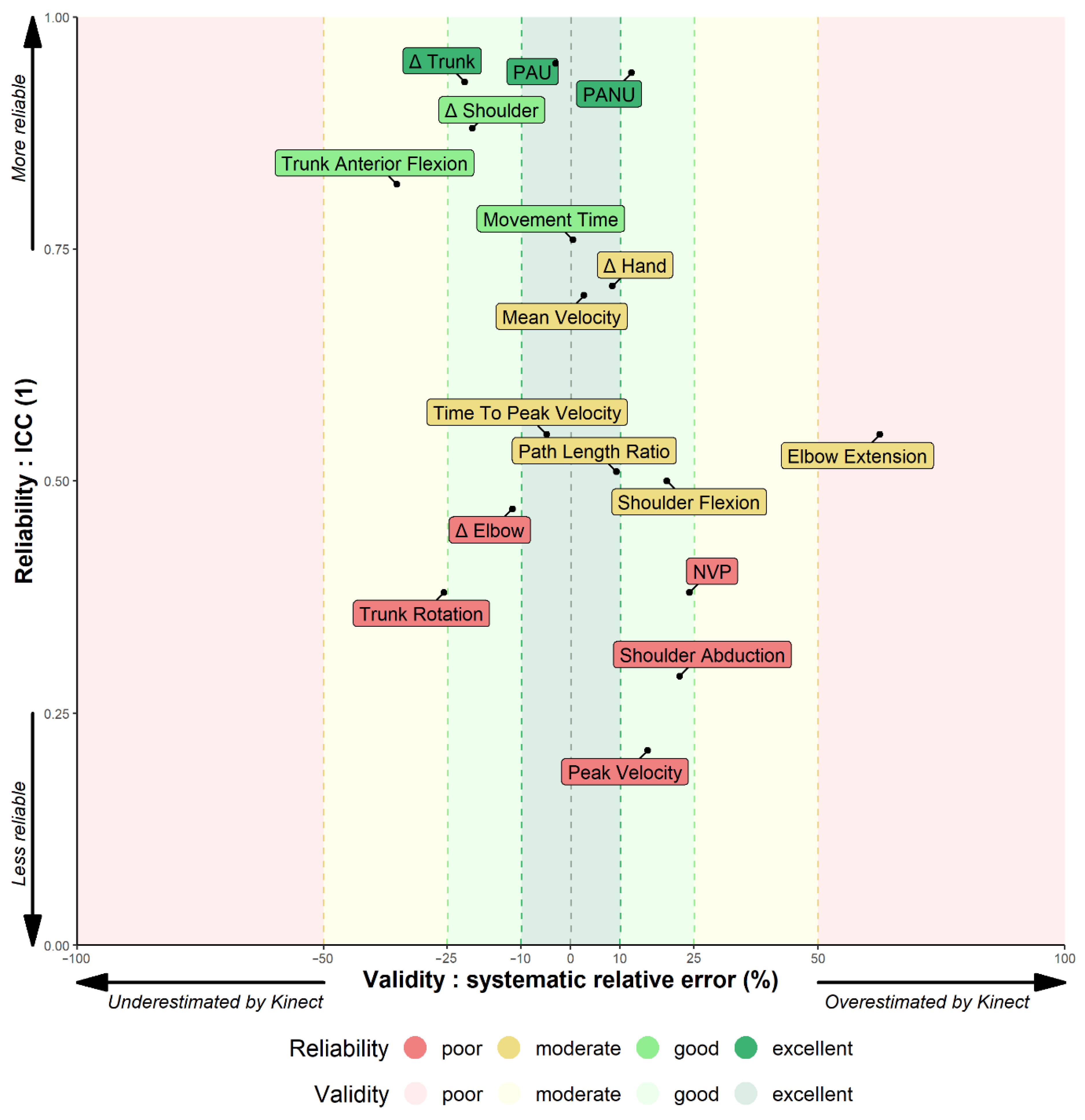
| Type | Variable | Reliability | ICC | r2 | RMSE | NRMSE | Validity | Direction of Systematic Error | Absolute Systematic Error (Bias) | Relative Systematic Error | Figure |
|---|---|---|---|---|---|---|---|---|---|---|---|
| Angle | Elbow extension | Moderate | 0.55 | 0.56 | 20.96° | 24.59% | Poor | Overestimation | +13.95° (±15.67) | +62.5% (±70.2) | Figure 3—Top panel |
| Shoulder abduction | Poor | 0.29 | 0.13 | 11.72° | 24.53% | Good | Overestimation | +2.67° (±11.44) | +22.0% (±94.7) | Figure 3—Middle panel | |
| Shoulder flexion | Moderate | 0.50 | 0.37 | 13.13° | 26.52% | Good | Overestimation | +6.61° (±11.37) | +19.4% (±33.4) | Figure 3—Bottom panel | |
| Trunk anterior flexion | Good | 0.82 | 0.73 | 3.28° | 11.40% | Moderate | Underestimation | −1.22° (±3.05) | −35.3% (±88.9) | Figure 4—Top panel | |
| Trunk rotation | Poor | 0.38 | 0.25 | 9.17° | 23.94% | Moderate | Underestimation | −4.10° (±8.22) | −25.7% (±51.6) | Figure 4—Bottom panel | |
| Efficiency | Movement time | Good | 0.76 | 0.58 | 0.41 s | 10.26% | Excellent | Overestimation | +0.01 s (±0.41) | +0.4% (±17.6) | Figure 5—Top panel |
| Path length ratio | Moderate | 0.51 | 0.48 | 0.18 | 17.20% | Excellent | Overestimation | +0.11 (±0.14) | +9.2% (±11.7) | Figure 5—Middle top panel | |
| Planning | Time to Peak velocity | Moderate | 0.55 | 0.32 | 0.34 s | 17.50% | Excellent | Underestimation | −0.05 s (±0.34) | −5.0% (±33.7) | Figure 5—Middle bottom panel |
| Smoothness | Number of Velocity peaks | Poor | 0.38 | 0.20 | 2.04 | 20.36% | Good | Overestimation | +0.84 (±1.86) | +24.0% (±53.8) | Figure 5—Bottom panel |
| Speed | Peak velocity | Poor | 0.21 | 0.11 | 204.42 mm·s−1 | 40.93% | Good | Overestimation | +63.04 mm·s−1 (±194.87) | +15.5% (±47.9) | Figure 6—Top panel |
| Mean velocity | Moderate | 0.70 | 0.53 | 40.32 mm·s−1 | 16.42% | Excellent | Overestimation | +4.91 mm·s−1 (±40.10) | +2.7% (±21.7) | Figure 6—Bottom panel | |
| Displacements | PANU | Excellent | 0.94 | 0.92 | 4.80 | 8.79% | Good | Overestimation | +1.88% (±4.43) | +12.3% (±28.7) | Figure S1— 1st panel |
| PAU | Excellent | 0.95 | 0.96 | 4.64 | 5.62% | Excellent | Underestimation | −2.88% (±3.65) | −3.1% (±4.0) | Figure S1— 2nd panel | |
| Δ Trunk | Excellent | 0.93 | 0.95 | 19.68 mm | 8.23% | Good | Underestimation | −15.04 mm (±12.72) | −21.5% (±18.2) | Figure S1— 3rd panel | |
| Δ Shoulder | Good | 0.88 | 0.86 | 34.76 mm | 11.30% | Good | Underestimation | −22.26 mm (±26.75) | −20.0% (±24.0) | Figure S1— 4th panel | |
| Δ Elbow | Poor | 0.47 | 0.37 | 61.04 mm | 17.14% | Good | Underestimation | −34.29 mm (±50.61) | −11.9% (±17.5) | Figure S1— 5th panel | |
| Δ Hand | Moderate | 0.71 | 0.73 | 40.33 mm | 14.54% | Excellent | Overestimation | +28.40 mm (±28.70) | +8.4% (±8.5) | Figure S1— 6th panel |
| Movement Time | Path Length Ratio | Time to Peak Velocity | NVP | Peak Velocity | |
|---|---|---|---|---|---|
| ICC before filtering | 0.64 | −0.12 | 0.19 | −0.30 | −0.05 |
| ICC after filtering | 0.76 | 0.51 | 0.55 | 0.38 | 0.21 |
Publisher’s Note: MDPI stays neutral with regard to jurisdictional claims in published maps and institutional affiliations. |
© 2022 by the authors. Licensee MDPI, Basel, Switzerland. This article is an open access article distributed under the terms and conditions of the Creative Commons Attribution (CC BY) license (https://creativecommons.org/licenses/by/4.0/).
Share and Cite
Faity, G.; Mottet, D.; Froger, J. Validity and Reliability of Kinect v2 for Quantifying Upper Body Kinematics during Seated Reaching. Sensors 2022, 22, 2735. https://doi.org/10.3390/s22072735
Faity G, Mottet D, Froger J. Validity and Reliability of Kinect v2 for Quantifying Upper Body Kinematics during Seated Reaching. Sensors. 2022; 22(7):2735. https://doi.org/10.3390/s22072735
Chicago/Turabian StyleFaity, Germain, Denis Mottet, and Jérôme Froger. 2022. "Validity and Reliability of Kinect v2 for Quantifying Upper Body Kinematics during Seated Reaching" Sensors 22, no. 7: 2735. https://doi.org/10.3390/s22072735







